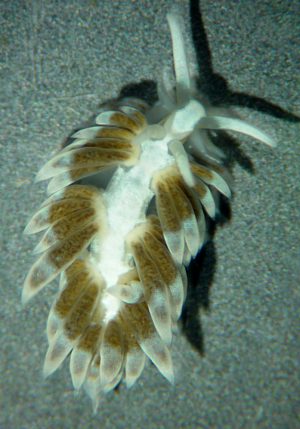
Aeolidiella stephanieae
Valdes, 2005
Order: NUDIBRANCHIA
Suborder: AEOLIDINA
Family: Aeolidiidae
DISTRIBUTION
Known only from the Florida Keys region, Florida, USA. but widespread in Nth American aquarium trade.
PHOTO
Florida Keys. It is a juvenile, about 1/2 - 3/4 inch long, but it looks essentially the same as an adult
The animal is translucent with most of the dorsal surface obscured by an opaque white patch which runs from the front of the head back between the oral tentacles before narrowing to pass beween the rhinophores before broadening again to fill the space between the ceratal clusters. From the photographs I have seen it seems that the white pigmentation also runs down each side of the body as well, but leaves a space around each ceratal cluster.
The foor appears translucent but there is a white line along the leading edge of the tentacular anterior foot corners. The basal third of the oral tentacles and rhinophores is translucent clear while the upper two-thirds is opaque white.The lower two-thirds of each ceras appears translucent clear with the brownish digestive gland showing through. The upper third of each ceras ihas some whirte pigmentation. The colour of the ceratal digestive gland depends on the state of the digestive cycle, as the colour results from the presence of zooxanthellae which are symbionts of the anemones that Aeolidiella feeds on.
The oral tentacles are smooth, while the rhinophores bear a few (5-6) obscure lamellae. The cerata are slightly flattened in shape and arranged in four clusters down each side. Withiin the clusters (or groups) the cerata are arranged in vertical rows.
This is the animal which Stephen Kempf has done so much work on, under the name Berghia verrucicornis [see message #6472]. It has been sold under that name in the aquarium trade as a way of cleaning Aiptasia infestations from aquaria. Steve Kempf suggests that the short-term retention of zooxanthella in the ceratal digestive gland illustrates a very early stage in the evolutionary process which led to solar-powered sea slugs.
-
Carroll, D.J. and S.C. Kempf. (1994). Changes occur in the central nervous system of the nudibranch Berghia verrucicornis (Mollusca, Opisthobranchia) during metamorphosis. Biological Bulletin, 186: 202-212.
-
Kempf, S.C. (1991). A "primitive" symbiosis between the aeolid nudibranch Berghia verrucicornis and a zooxanthella. Journal of Molluscan Studies, 57: 75-85.
-
Carroll, D.J. and S.C. Kempf. (1990). Laboratory culture of the aeolid nudibranch Berghia verrucicornis (Mollusca, Opisthobranchia): Some aspects of its development and life history. Biological Bulletin,. 179: 243-253.
-
Valdés, A. (2005) A new species of Aeolidiella Bergh, 1867 (Mollusca, Nudibranchia: Aeolidiidae) from the Florida Keys, USA. The Veliger, 47: 218-223.
Note: The animal used for Aiptasia control under the name Berghia verrucicornis is not that species. It is Aeolidiella stephanieae. See separate page for messages and discussion on 'Berghia verrucicornis' in aquaria [buying, selling, where to obtain, Aiptasia control etc].
Authorship detailsRudman, W.B., 2005 (August 20) Aeolidiella stephanieae Valdes, 2005. [In] Sea Slug Forum. Australian Museum, Sydney. Available from http://www.seaslugforum.net/find/aeolstep
Related messages
Re: Berghia verrucicornis - aquarium culture [1]
June 11, 2007
From: Stephen C. Kempf
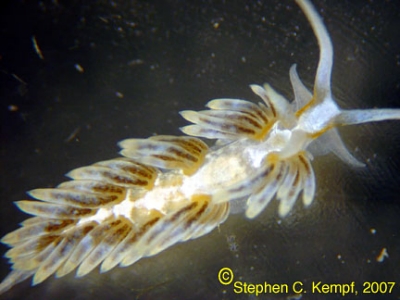
Concerning message #6364:
Bill,
I don't recall if I ever sent the pictures of the "real" Berghia verrucicornis (the one that was called that in the USA but is now Aeolidiella stephanieae ) a few years ago, but just in case I didn't, I'm sending them now. I've also included some pictures of Aiptasia pallida (from the Florida Keys) in a second message [#19966], and the zooxanthellae in Berghia's cerata.
Locality: Florida Keys, USA, 1-3 ft, Florida, Monroe, Atlantic Gulf region, USA, Near Intertidal specimens, lab reared. Length: 2-3 cm. Photographer: Stephen C. Kempf.
Enjoy,
Steve
kempfsc@auburn.edu
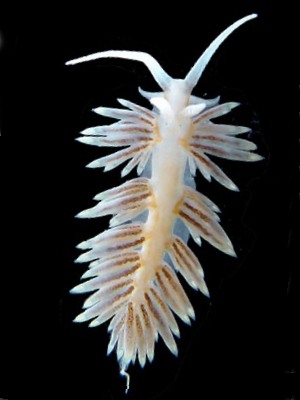
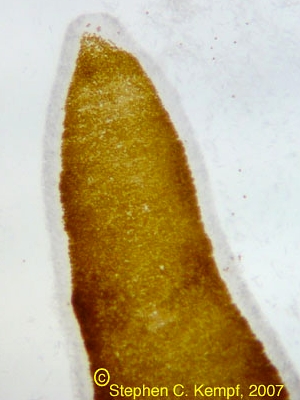
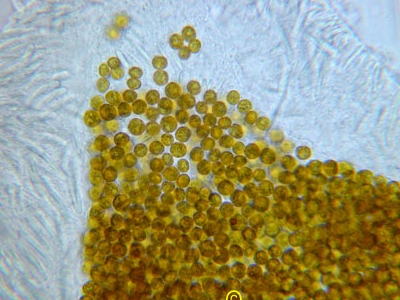
Dear Steve,
You did send some photos before [message #6472], which confirmed in my mind at least that your animal was not the Mediterranean Berghia verrucicornis. Later Angel Valdes described it as A. stephanieae [message #14603 ].
These extra photos are very welcome as they show us some of the colour variation and the zooxanthellae which this species temporarily retains from its food anemone Aiptasia.
Best wishes,
Bill Rudman
Re: 'Berghia verrucicornis' - Captive Life Span
March 29, 2006
From: Lisa Brown


Concerning message #16062:
Thanks for your posted response to my question Bill. Here are some photos of our aquarium bred Aeolidiella stephanieae. [Photo and copyright(C)Lisa Brown 2006].
Thanks again,
Lisa Brown
saltyunderground@yahoo.com
Brown, L., 2006 (Mar 29) Re: 'Berghia verrucicornis' - Captive Life Span. [Message in] Sea Slug Forum. Australian Museum, Sydney. Available from http://www.seaslugforum.net/find/16191
Dear Lisa,
Thanks for these photos. It has been very hard to get photos of aquarium bred animals. I particularly like the one with the animals all massed around the luckless anemone. From the variation in colour it would seem colour depends a lot on the feeding cycle and the colour of the anemone being eaten. One thing not mentioned in the original description is the long thin extension to the posterior end of the foot. Very few species have such a noticeable extension and those that due are often living on large brown algae. I assume it is quite sticky so enabling the animal to stay in place even when currents are washing through algae. It would be interesting to know more about this species in its original habitat
Best wishes,
Bill Rudman
New name for Aiptasia-feeding aeolid
August 20, 2005
From: Bill Rudman
Angel Valdes has recently named a species of Aeolidiella from Florida as A. stephanieae. This is the animal which Stephen Kempf has done so much work on, under the name Berghia verrucicornis and which I have long doubted was the same as the Mediterranean species [see message #6472]. It has been sold under that name in the aquarium trade as a way of cleaning Aiptasia infestations from aquaria. [see also 'Berghia verrucicornis' - in aquaria Page ]
Although not cited by Valdes, there are a number of important publications by Steve Kempf concerning this species, under the name B. verrucicornis. Steve suggests that the short-term retention of zooxanthella in the ceratal digestive gland illustrates a very early stage in the evolutionary process which led to solar-powered sea slugs.
-
Carroll, D.J. and S.C. Kempf. (1994). Changes occur in the central nervous system of the nudibranch Berghia verrucicornis (Mollusca, Opisthobranchia) during metamorphosis. Biological Bulletin, 186: 202-212.
-
Kempf, S.C. (1991). A "primitive" symbiosis between the aeolid nudibranch Berghia verrucicornis and a zooxanthella. Journal of Molluscan Studies, 57: 75-85.
-
Carroll, D.J. and S.C. Kempf. (1990). Laboratory culture of the aeolid nudibranch Berghia verrucicornis (Mollusca, Opisthobranchia): Some aspects of its development and life history. Biological Bulletin,. 179: 243-253.
-
Valdés, A. (2005) A new species of Aeolidiella Bergh, 1867 (Mollusca, Nudibranchia: Aeolidiidae) from the Florida Keys, USA. The Veliger, 47: 218-223.
Bill Rudman
Rudman, W.B., 2005 (Aug 20) New name for Aiptasia-feeding aeolid. [Message in] Sea Slug Forum. Australian Museum, Sydney. Available from http://www.seaslugforum.net/find/14603Photo of 'Berghia verrucicornis' from Florida
March 22, 2002
From: Stephen C. Kempf

Note added 20 August 2005: This species has been named Aeolidella stephanieae.
Bill,
Here's a fair picture of the animal which we breed here and is used in the aquarium trade to control Aiptasia. We call it Berghia verrucicornis. This is from the Florida Keys. It is a juvenile, about 1/2 - 3/4 inch long, but it looks essentially the same as an adult. The coloration is correct. The brown is due to the zooxanthellae from it's last meal. It maintains these temporarily in the cells lining the digestive diverticula, but will lose them over time if not fed. If these Berghia are reared on bleached Aiptasia, [anemones without zooxanthellae] there is no colored pigment (they appear white to the casual observer). Close inspection reveals a yellow tint to this whiteness with some regions whiter than others. I had to take this shot through my dissecting microscope while the animal was moving, thus the slight fuzziness. I'll try to get a better picture once these animals get larger.
Steve
http://www.auburn.edu/research/hybridoma/
kempfsc@auburn.edu
Kempf, S., 2002 (Mar 22) Photo of 'Berghia verrucicornis' from Florida. [Message in] Sea Slug Forum. Australian Museum, Sydney. Available from http://www.seaslugforum.net/find/6472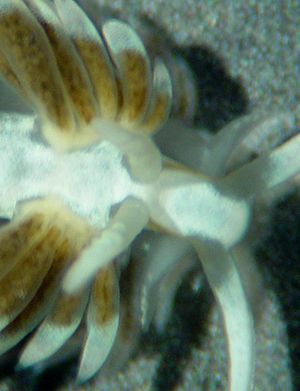
Dear Steve,
Thanks very much for this photo. This is the first decent illustration I have seen of the 'USA model' of Berghia verrucicornis and from its external features I would be very surprised if it is the same as the Mediterranean species.
Apart from the obvious colour differences - orange patches in the Mediterranean, white in Florida, there is also the shape of the rhinophores and the cerata. The rhinophores of the Mediterranean animal are reported to have prominent tubercles on the posterior face of the rhinophores merging into ridges along the sides. In your animal there appear to be traces of ridges Are there also tubercles? The cerata of Mediterranean animals are described as spindle-shaped while in your animal the cerata appear to be quite flattened?
I can't be 100% certain from a photo so would be grateful for some information on the shape of the cerata and rhinophores. Apart from the need to compare their anatomy it would also be useful to compare their egg ribbons and developmental biology.
best wishes,
Bill Rudman
